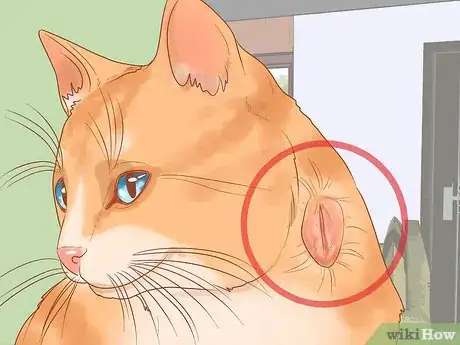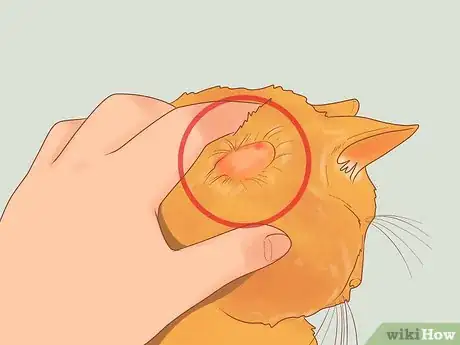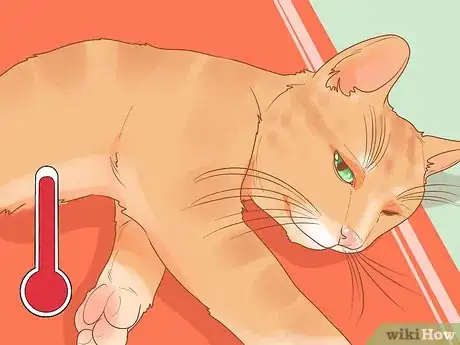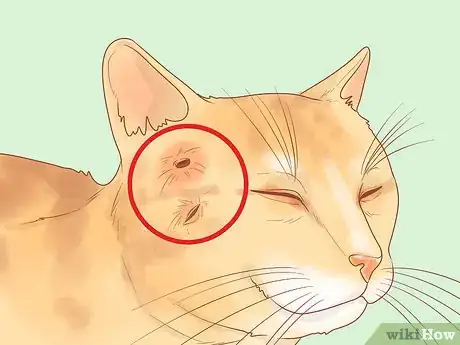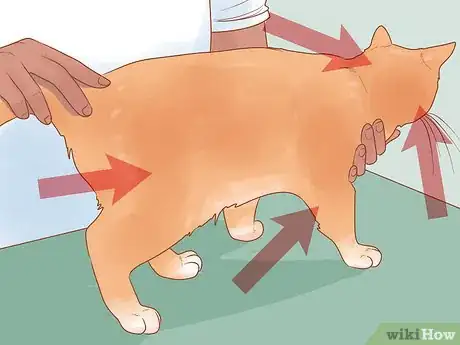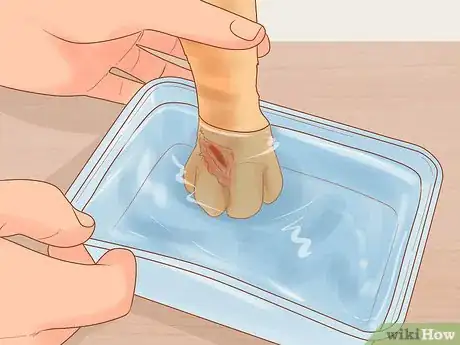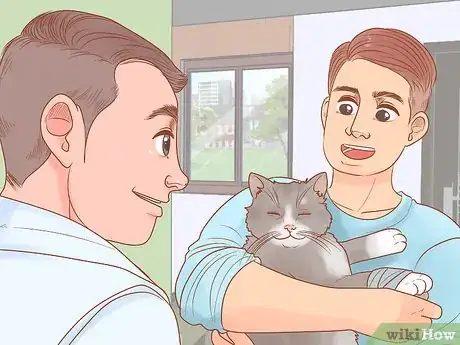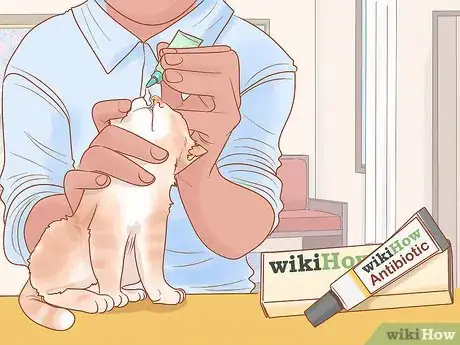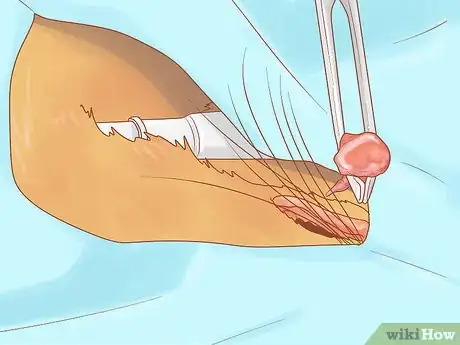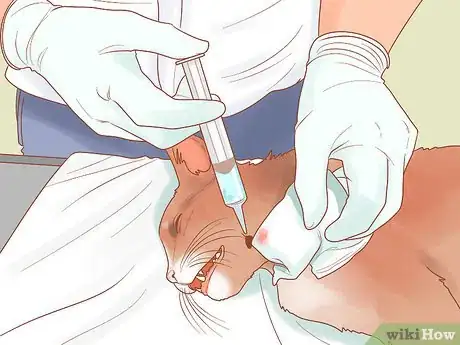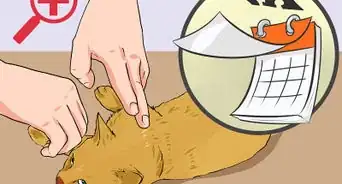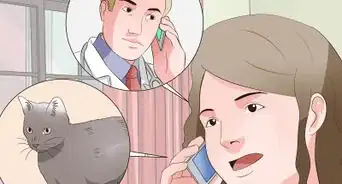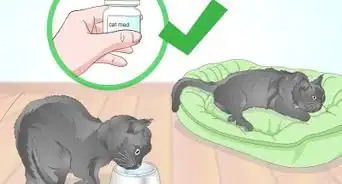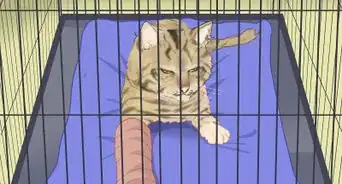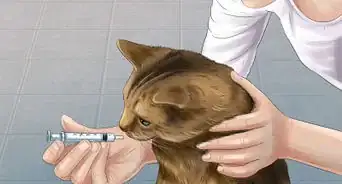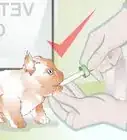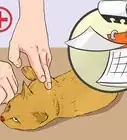This article was co-authored by Lauren Baker, DVM, PhD. Dr. Lauren Baker is a Veterinarian and Assistant Scientist at the University of Wisconsin-Madison. With over 10 years in veterinary medicine, she specializes in the concept of “one health,” which uses insights from veterinary medicine to help human medical research. She holds a Ph.D. in Comparative Biomedical Sciences, a Doctor of Veterinary Medicine, an MS in Comparative Biomedical Sciences, and a Bachelor’s degree in Psychology from the University of Wisconsin-Madison.
This article has been viewed 98,350 times.
Cats sometimes get into a fight when they come across new cats or want to establish dominance. When cats fight, they use their teeth, which can lead to bite wounds. When a cat bites another cat, their teeth transmits bacteria to the wound. These bites heal over quickly, which causes the bacteria to get trapped under the skin. This can lead to infections and abscesses.[1] To treat fight wounds, take you cat to the vet as soon as possible, get it antibiotics, and have any abscesses drained.
Steps
Signs and Symptoms
-
1Look for any wounds. You may notice bleeding or sores on your cat if it has been in a fight. You may also check its body to look for scabs since bite wounds heal over quickly. You can also run your hands over the body to check for any tender areas that cause the cat pain.[2]
-
2Check for swelling. If a cat gets into a fight, you may not know about it. The puncture wounds will close over and trap bacteria in the skin. This will lead to swelling where the cat was bitten. Check the cat’s body for any swelling.[3]
- The most common places a cat will get bitten is the head, neck, forelimbs, and the base of the tail.
Advertisement -
3Monitor for a fever. Cats who are developing an infection and abscess will have skin that is hot around the infection site. The cat may also develop a fever. This will cause the cat to be lethargic and have an overall sickly disposition.[4]
-
4Watch for other signs of a bite. Your cat may show others signs that let you know it has been in a fight. In cats with leg bites, the infection makes walking painful so it may start limping. Sometimes, the cat will groom and lick the area of the bite excessively.[5]
- In rare cases where the cat may have sustained a bite to the chest, you may notice that your cat has problems breathing.
Assessing the Wound
-
1Check your cat’s entire body. If it is after hours and you can’t get your cat to the vet immediately, try to administer some first aid on the wound. Look at your cat’s entire body to determine where it has sustained damage. If there is matted hair, clip it so you can get a better look at the wound.[6]
- You can also try to place a warm compress on the injured site. Hold the cloth on the wound for a few minutes to help loosen fur and clean some of the blood.
- Be careful not to get bitten. Your cat may not let you do this because it is in too much pain.
-
2Clean the bite. If your cat has a surface bite, flush the area with sterile saline. If you don’t have sterile saline, rinse the area with warm water. Don’t use rubbing alcohol or hydrogen peroxide, which could damage the healthy tissue.[7]
-
3Determine if the cat can wait until the vet opens. When you have cleaned the wound, assess the damage. Many fight wounds are superficial and can be dealt with during regular business hours. If the wound is bleeding profusely or damaged part of the body like the throat or eye, you should get your cat help immediately.[8]
- If your cat acts okay, if it is eating, and if it doesn’t seem like it has sustained nerve damage, it should be okay until you can get it to the vet.
Treating Wounds
-
1Take the cat to the vet as soon possible. When cats get in a fight, the teeth and claws puncture the skin, which traps bacteria under the skin when it closes over. If the infection doesn’t get treated soon, it can lead to more serious symptoms. Some bite wounds can lead to blood loss, nerve damage, and trauma to organs.[9]
- As soon as you discover your cat has gotten into a fight, take it to the vet. Getting the cat treatment as soon as possible can save it from developing infections and unnecessary pain.
-
2Give your cat antibiotics. The vet will give you antibiotics to give to your cat. If the antibiotics are given within 24 hours, this will help stop the infection from spreading. Giving the cat antibiotics early can prevent more serious problems, like an abscess, from occurring.[10]
- Make sure to give your cat all the antibiotics the vet gives you.
-
3Have the abscess drained. If the infection has turned into an abscess, the vet will have to drain the infection and flush it out with a saline solution. In some cases, the vet can do this by removing the scabs. However, the most common way to drain the abscess is to lance the skin.[11]
- Your cat may need to be sedated or put under anesthesia for this procedure.
-
4Have the affected tissues removed. If your cat has a large abscess, the vet may remove the tissues that have been affected by the abscess, including any inflamed tissues surrounding the infection. Some abscesses lead to dead tissue around the infection site.[12]
- After this, the vet will close the area with sutures.
-
5Get a surgical drain for the wound. Most fight wounds will require a surgical drain to be placed in the wound. This helps any pus or discharge drain from the wound. If the vet places this into the wound, you will have to clean the hole multiple times a day for several days.[13]
-
6Clean the site. After your vet drains the abscess, the wound may be left open to continue draining and healing. You will have to clean this area twice each day for a few days. To clean it, you will use cotton balls or gauze and warm water.[14]
- Some cats may be prescribed a surgical soap by the vet. Only use cleansers or soap prescribed by the vet. Human products or other disinfectants can be toxic to cats.
- Hydrogen peroxide should never be used on an abscess. It can make the area worse.
-
7Get blood tests. It is a good idea to get your cat tested after it gets into a fight. Cats can transmit infections through bite wounds. Common infections they can transmit include the feline immunodeficiency virus (FIV) and feline leukemia virus (FeLV). Ask your vet to test your cat’s blood to be safe.[15]
- Blood tests are often recommended for cats who do not get better after treatment.
References
- ↑ https://vcahospitals.com/know-your-pet/wounds-fight-wound-infections-in-cats
- ↑ http://www.petplace.com/article/cats/diseases-conditions-of-cats/emergency-trauma-urgent-care/bite-wounds-in-cats
- ↑ http://www.petplace.com/article/cats/diseases-conditions-of-cats/emergency-trauma-urgent-care/bite-wounds-in-cats
- ↑ https://vcahospitals.com/know-your-pet/wounds-fight-wound-infections-in-cats
- ↑ https://vcahospitals.com/know-your-pet/wounds-fight-wound-infections-in-cats
- ↑ http://www.petful.com/pet-health/cat-abscess-treatment-tips/
- ↑ http://www.petful.com/pet-health/cat-abscess-treatment-tips/
- ↑ http://www.petful.com/pet-health/cat-abscess-treatment-tips/
- ↑ https://vcahospitals.com/know-your-pet/wounds-fight-wound-infections-in-cats
- ↑ http://www.vetstreet.com/care/bite-wound-abscesses-in-cats
- ↑ https://www.vetwest.com.au/pet-library/fighting-wounds-and-infections-the-fighting-spirit
- ↑ https://www.vetwest.com.au/pet-library/fighting-wounds-and-infections-the-fighting-spirit
- ↑ http://www.peteducation.com/article.cfm?c=1+2141&aid=3607
- ↑ https://vcahospitals.com/know-your-pet/wounds-fight-wound-infections-in-cats
- ↑ http://www.vetstreet.com/care/bite-wound-abscesses-in-cats
About This Article
If your cat has sustained serious fight wounds, get help immediately from an emergency vet. Otherwise, if it’s out of hours and the wounds are superficial, you can treat them at home and take your cat in the next day. To treat a wound, cover it with a warm compress to loosen any fur and dried blood. Take care when doing this, since your cat may bite or scratch you if it’s in pain. After you’ve removed any dried blood, clean the wound using sterile saline, or warm water. Then, if possible, wrap a clean bandage around the wound to protect it until you visit the vet. For more advice from our Veterinary co-author, including how to check your cat’s body for signs of a bite, keep reading!
